Samitivej Sukhumvit Hospital
Bangkok, Thailand
I write this sitting in Samitivej Sukhumvit Hospital in Bangkok. Mary Ellen just entered the surgery room to install four metal plates in her arm to realign her shattered forearm and hand. She is an angel, stronger than she has any right to be. Stronger than me, that’s for sure.
Thahkek Loop
One week ago we were in Laos, heading north from Cambodia on rickety busses crammed in between chickens and children.
The busses crawled along at walking pace, stopping constantly at markets to take on chickens and at street corners to take on passengers. It took three days of travel to get to Thakhek, a small town in central Laos where the dust and plains of the south start to give way to the limestone hills and jungles of the north.
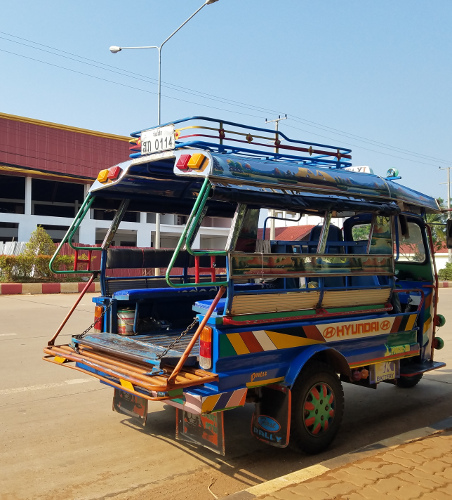
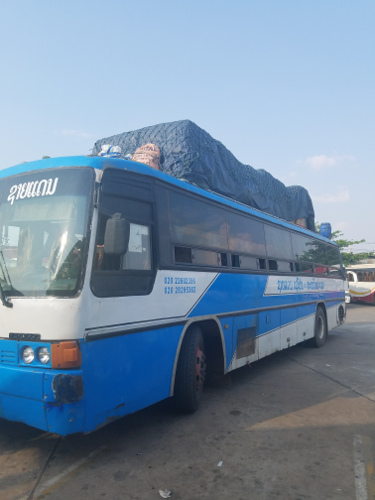
We were here, along with dozens of other travelers, to ride the Thakhek Loop, a three day, 350km scooter ride through the gorgeous transitional scenery. We rented our scooters and helmets and took off with a crowd of others. The first day we drove through beautiful scenery, curvy mountain roads twisting through the jungle, rice fields dry from the droughts criss-crossed by caravans wandering oxen, mountains surrounding everything.
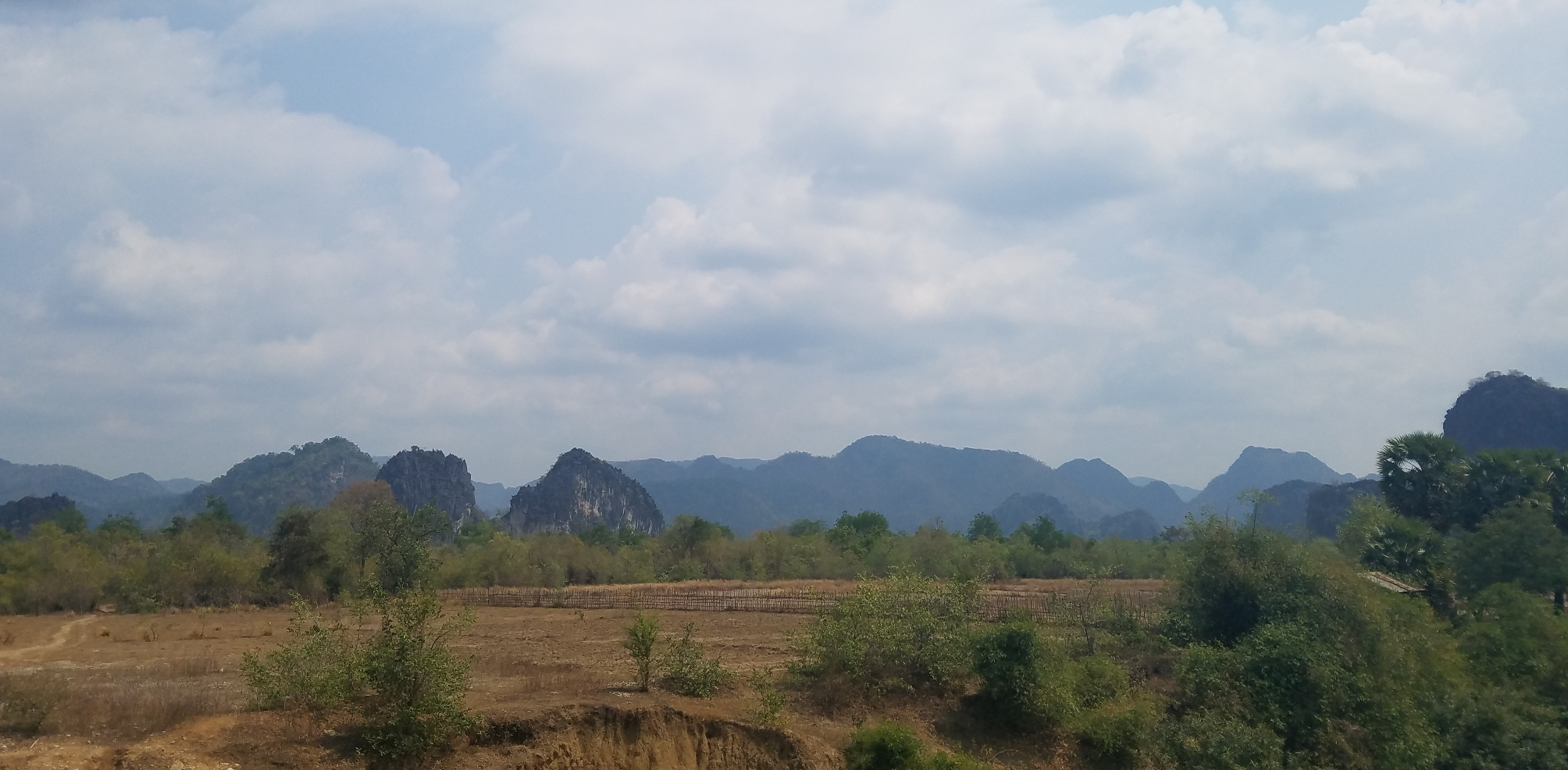
The morning of our second day we joined Harvey and Mette who we befriended at breakfast that same day. We took off on the road as it wound its way through a flooded plain, dead trees broke the mirror surface of the lake.
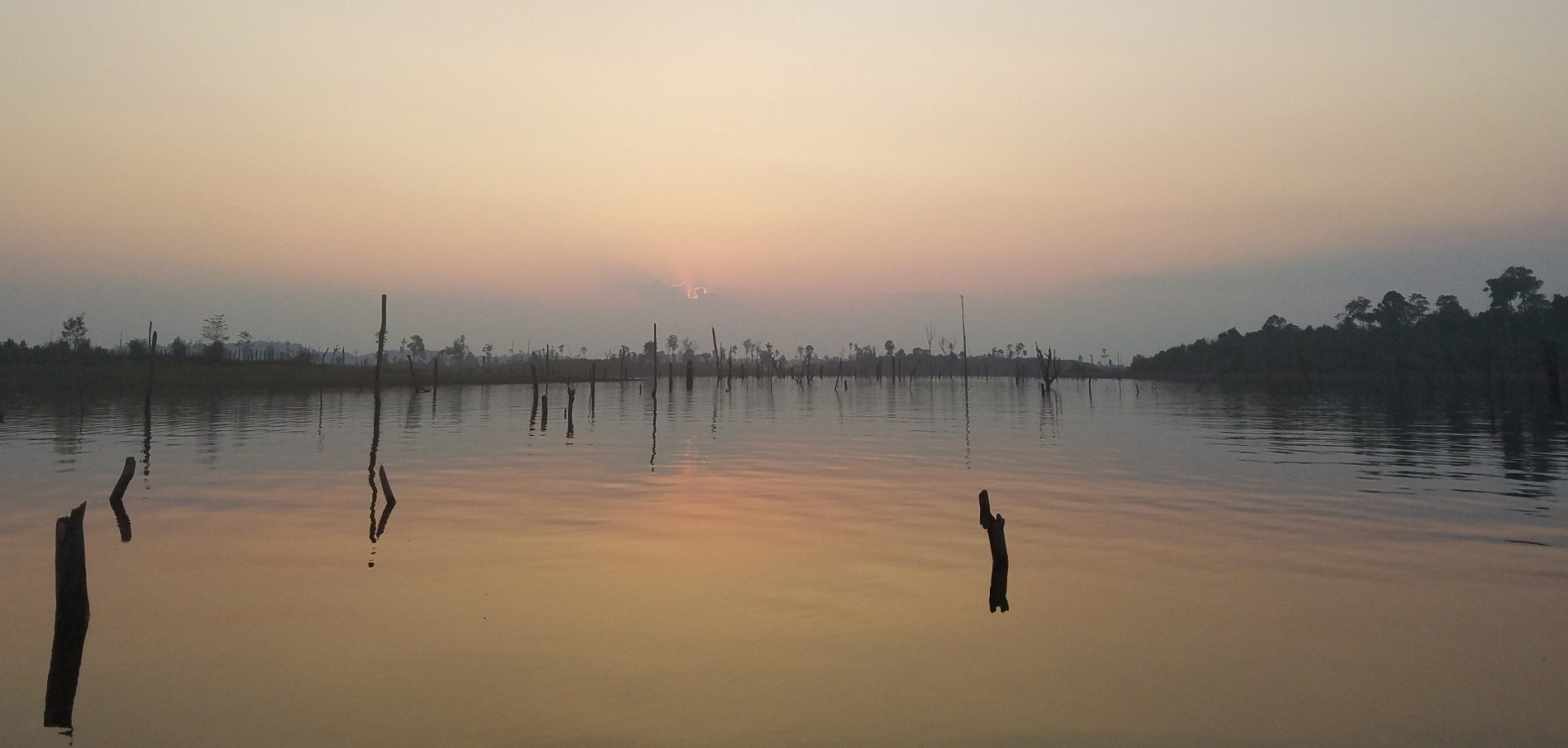
We stopped for lunch in Lak Sao then continued on. We were 14km outside of town, cruising on the right shoulder of an open, two lane country road. We were driving about 25mph and Mary was leading the caravan, followed by me, Mette and Harvey. Without warning, without alert, I feel the deep bass rumble of a large vehicle. The loud roar of the engine fills my perception.
Typically, drivers in Southeast Asia have no compunctions about moving into the wrong lane for a considerable amount of time to overtake drivers or pedestrians. Roads are full of slow tractors or cows or children driving children on bicycles. Not this man. He buzzed me so close I could have touched his tire. I turned my head as he passed and held my breath as I tried to keep a straight line. I looked forward at Mary Ellen, surely he would have seen how close he had came and would move over!?
He drifted even further to the right shoulder. Mary was as far over as you could get before the concrete turned to gravel and potholes. I watched in a horrible fascination as he came closer and closer. My vision narrowed and my thoughts raced. I could honk or shout, I was close enough. But any honk may cause her to turn her head, to look at me. Any move could turn a near miss into a near hit. I did nothing, positive that we would all have a laugh later about the adrenaline rush this inconsiderate drivers had given us.
His vehicle was huge and loud and a terrible machine. A dump truck with 6 tires, each as tall as we were on the scooters. He came closer and closer. In a millisecond my fear turned to horror. His back right tire hit Mary’s side mirror, the object that stuck out the furthest. It exploded and the bike was pulled into the tire. I was certain I was going to watch my wife, my best friend in the entire world, go under a tire and die in front of me and there was not a single thing to do. The bike contacted the tire and either the impact shot the bike out or Mary jerked the handlebars when she realized what was happening. The bike was thrown to the right and Mary was too, clear of the wheels. The bike and Mary tumbled like dolls into the ditch. Mary hit the ground clear of the tires and the bike and rolled and tumbled, coming to rest on her stomach.
I honked and honked my horn, shouting but the truck lumbered on. Unaware or unconcerned that he may have just murdered somebody. Not just someone, my Mary Ellen, my wife.
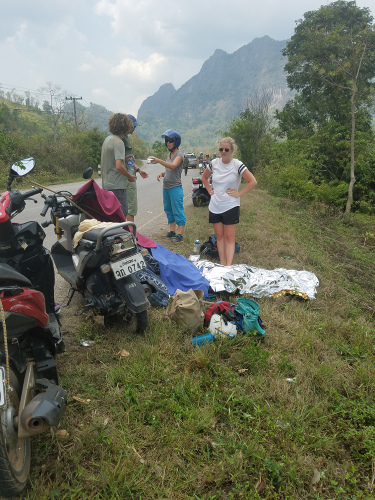
I pulled over and we were quickly joined by Harvey and Mette. I was shaking and felt sick. I ran over to Mary and she was conscious. She could talk. She could wiggle her toes. I didn’t know what to do to help and we had extremely limited supplies. No one had a SIM card in their phone and, even if we did, coverage in Laos is horrible and slow. I took a breath. We kept her still, fearing for a back or neck injury. She was in a lot of pain, awake but a little dizzy and loopy. Her hands were out in front of her, bent and she was laying flat. Her left hand had two large punctures and were oozing blood. I ran and grabbed my handkerchief and pressed it to stop the bleeding.
She had taken her helmet off immediately after coming to a rest. It’s a little funny to me to think that the first thing she did after realizing she was still alive was to peel off that heavy, sweaty thing. Her face and head were free of injuries. Her back was scratched up from the gravel but her long pants and long sleeves saved her the worst of the road rash. Fellow bikers and a crowd of Laotians gathered. With difficulty we explained the situation and asked for cops and an ambulance.
A knowledgeable and calm Swiss gentleman stopped with some medical supplies. He sprayed down her road rash with an antiseptic wash and we covered her from the sun with towels and a space blanket. We gave her sips of water as we talked to her, trying our best to explain the chaos of the situation. Fellow riders were parked ahead and behind on the roadway to slow cars down as they approached. We were still waiting for an ambulance from Lak Sao. No one who spoke English had cell service but the locals were able to get the police and, after an hour, an ambulance to get her to the nearest medical facilities in Lak Sao. That hour stretched and tugged at my anxiety, should we be doing more!? Should we use the services of a passing truck to get her to town!? I was pacing and sweating and dazed. I hated the not knowing. The uncertainty of our actions.
The sun was hot and beating and we were all concerned about dehydration and shock. Luckily she stayed lucid, able to talk with clarity and candor. She was in pain. Her left arm appeared broken but we couldn’t find anything else seriously wrong. Her back hurt and her neck hurt, but everyone, Mary included, seemed to think that was mostly because she had been hit by a truck. Things tend to hurt after that.
The ambulance driver wasn’t much more than that, a driver. He wheeled out the stretcher and motioned that she should just…get on? Even though we were pretty certain that she didn’t have a broken back, the rest of us were still duly concerned about her condition and did not want her to have to get up. Harvey dug around in the ambulance and found a thin backboard and we use that to load her onto the stretcher and into the ambulance for the 14km back to Lak Sao.
Mette and Harvey stayed with our bikes to get them back to the city. The bikes would be examined by the cops and then would eventually be evacuated with us to Thakhek. I rode in the ambulance holding Mary’s hand and stroking her hair. She was crying out from the pain. Every bump, every pothole wracked her body and her arm.
We arrived at the “hospital” which was no more than a rural outpost offering exceptionally rudimentary care. They wheeled her into the examination room, a single green chair sat in the middle of a plain tile floor. Flies buzzed around the open air room and the nurses and one doctor trod around in flip flops. Ah, I said to myself, This is how people die traveling in third world countries. Instead of relaxing once she was in the care of the nurses and doctors I was feeling more anxious, more alert.
After some confusion, we cut her shirt off. Actually I cut her shirt off because the staff were concerned about her modesty. We tried our best to explain that we didn’t actually care about her modesty, we cared about her safety. They refused to take her pants off, instead, they were slighting pulling them down to swab at the cuts on her butt. They swabbed every minor cut and scrape before getting to her leaking hand and broken arm. At one point they made her lift her broken arm so they could put a plastic shopping bag underneath the arm, ostensibly to keep the blood off their stretcher. Priorities were off-kilter. The doctor kept stopping to wipe her blood off his gloves. He didn’t bother changing gloves, just kept wiping the blood off.
The team bandaged her wounds with no painkillers. Her hand and arm were splinted with two pieces of bamboo wrapped in gauze. No real standards for care were followed. No one asked our names or looked at our passports. No one checked her heart rate or her blood pressure. We tried to explain her allergies to sulfa but that was a non-starter.
I paid in cash while her arm and hand were x-rayed. Luckily they had the facilities to check for broken bones but no ability to treat the broken limbs. The X-rays revealed four complete breaks of her ulna and fingers.
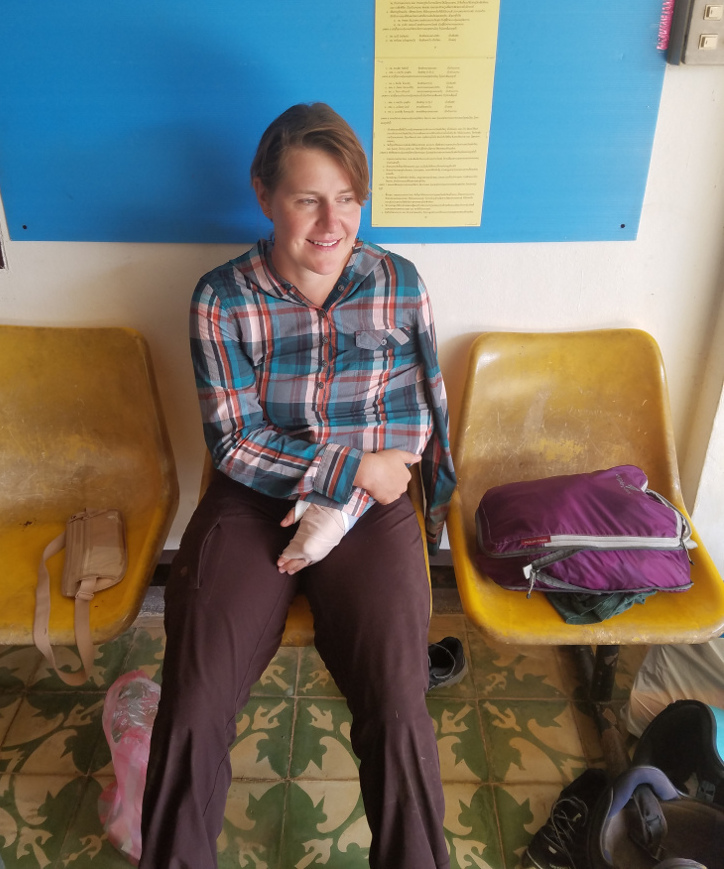

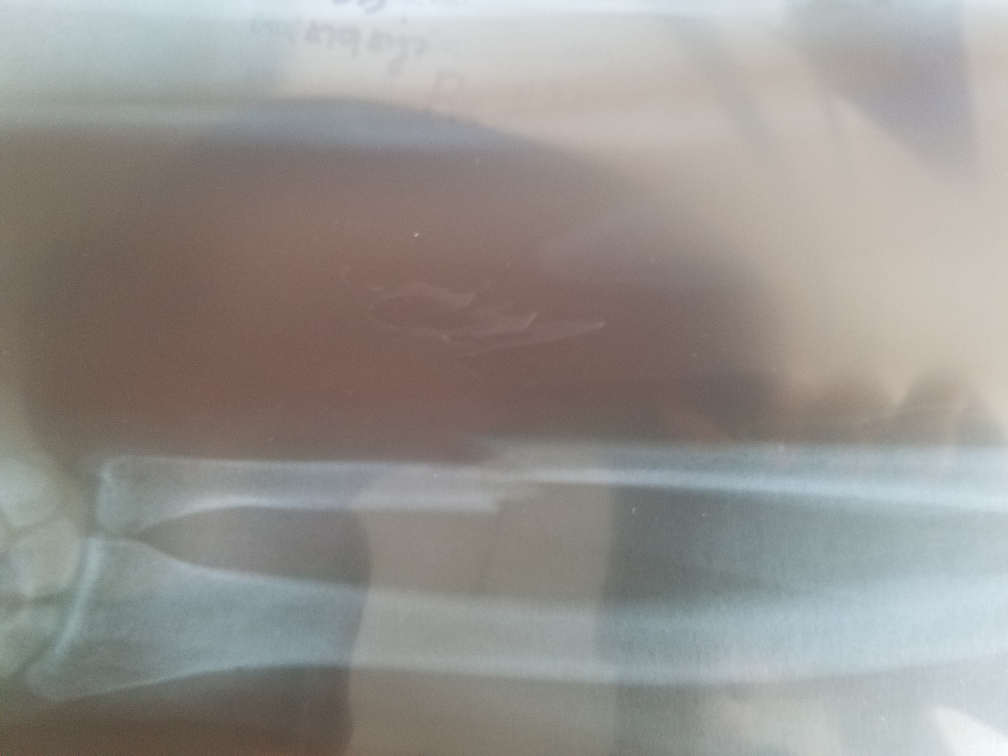
We waited in the hall for three hours for a ride back to Thakhek. As we waited, we saw another young man wheeled into the same emergency clinical room Mary was just in. His foot was wrapped in an old t-shirt and was dripping blood rhythmically as his family pushed him into the room. The blood left trail from the front door of the clinic into the room. No one came to clean the blood and we tip-toed around the mess as we walked away.
In Thakhek we were dropped off at the rental agency where the owner, luckily, spoke English quite well. We discussed the damages to the bike and he suggested we contact our insurance company right away to start the claims process. They tried to inquire about the police and the hit-and-run suspect but I told him that was a dead end. We left Lak Sao and took the bike and the officer we had been working with had disappeared. I think the whole thing was probably forgotten by dinner time.
Mr. Wang from the rental agency charged us very little for the bike repairs. The damage to the bike was minimal and so we only had to pay for cosmetic repairs. According to our contract we could have been out $2500 for a full replacement and I was in no mood to fight or argue or defend ourselves. His kindness was much appreciated.
For medical treatment help, I called the insurance company and they suggested we either go to Vientiane (capital city of Laos) or Bangkok. Luckily for us, there were no flights to Vientiane so we had to take a bus to Thailand the next day. I say luckily because we later found that the damages were too severe for a normal cast and any casting would probably have resulted in either reduced arm mobility and strength or we would just have been sent to Bangkok anyway.
Thahkek to Bangkok
So we took a morning bus across the border. Actually, we took a taxi to the bus station, followed by a bus across the border. Then, we took a taxi to the airport where we had booked an 11:45am flight to Bangkok. I go to check-in at this tiny local airport and they take a look at Mary’s arm in a sling.
“When did that happen?” They ask, innocently.
“Yesterday”, we say, stupidly.
“Do you have certificate? From doctor?”
“What are you talking about?” We say.
Yes, it turns out in order to get on a flight to go see a doctor you need a doctor to sign off that you can, in fact, get on the flight. We tried raising our voices but they were adamant. We tried crying too, but that was more out of frustration. That also did not work, unfortunately.
So I sprint outside yelling “Taxi!” “Leiu Leiu! Quickly Quickly!”
We get a taxi driver to speed the 15km to the hospital and run inside. They immediately start trying to triage Mary and we have a bit of trouble explaining that we just need a sign off from a doctor so we can fly. She’s not dying, we try to explain, she’s just injured. It seems like they are trying to do everything the doctors in Lak Sao did not do. “Thanks” I want to yell, “but there is no time!”
Even with the mishaps, I can’t help but be happy we are in Thailand where the hospitals are indoors and the nurses wear shoes and there is no blood on the floor. Eventually Mary gets ushered back into the ER and I pace outside, feeling all the things I cannot control spin around me.
Eventually Mary returns with a certificate rubber stamped to allow her to fly (obviously, what were they going to say??) and a bill for 200 baht, 7 dollars. So now I get to stand in line to pay the bill while our countdown to departure time ticks inexorably to zero. Of course there is a woman in front of me disputing her charges and getting a hundred receipts like a hospital version of an extreme couponer. Thai nationals pile up behind me, all pushing towards the glass. I’m normally pretty passive in these situations but I use my height and size advantage to force them to queue. No one will get in front of me! We pay the bill and race outside to find a tuk tuk. Back to the airport we race, through traffic and stoplights that frustratingly tell you how long you will be waiting with a glowing countdown (90 seconds! What kind of city is this!). Mary winces with every acceleration, break, and pothole while clenching the bamboo splints tighter around her broken bones. We make it to the airport right before departure time, race through check-in (but not without paying for one overweight bag! They sure know how to eek out every dollar) and make it on the flight. This may sounds like a TV show scene but the reality of the situation was much less adventurous and fun. My wife was in excruciating pain, every jarring bounce of the taxi ground the ends of her bones against each other. Every minor setback pushed us further from our 11:45am flight and closer to the only other flight that day, an 8:45pm flight. The attendants attempt at being friendly by saying she wouldn’t charge us to push our flight back incensed us more than placated us. That would mean nine more hours of waiting for infection to set in! Nine more hours with rudimentary bandages and no painkillers! We were scared - as scared as we had been since the initial crash.
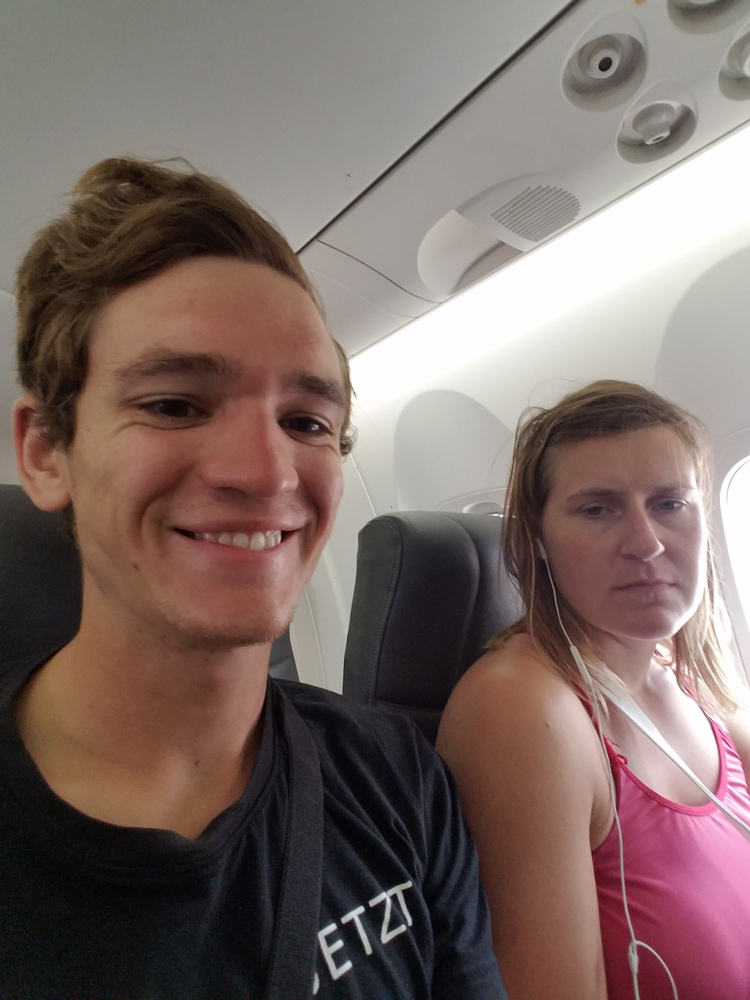
Fast forward through more transportation methods, and we are in Bangkok, standing at reception in Samitivej Sukhumvit Hospital. This place is the nicest hospital either of us have ever been in and the competence and efficiency of the staff puts our minds at ease. It feels like we are in a fancy hotel mixed with an upscale mall.
The orthopaedic surgeon re-dresses her wounds and gives a small laugh when the layers of gauze give way to reveal the bamboo splints.
“Was this in Thailand?” He asks.
No, we say. Laos.
“Ah.” There is a slight pause. “Traditional. We haven’t used bamboo in many years.”
Yes Doctor, “traditional” is one word for it. We are feeling a bit more comfortable about our situation. The risk of death seems to have drifted off and we let ourselves relax enough to smile along with him. There is humor here, intertwined with the tragedy and the heart break.
Mary has her x-rays redone and additional scans taken of her back and neck. Through it all we find that the doctors and nurses are waiting on us, for us to walk through the doors into the examination rooms.
Our doctor, Dr Phat, calls us back into his office where he has her x-rays up on the light box. He points out the breaks in her ulna and hand as well as an additional fracture of her sacrum and a bent coccyx.
He explains that these breaks are best served with surgery to install metal plates and pins to force proper bone alignment.
“Surgery?” We look at each other. We had, for some reason, always expected that this would be a simple cast. Neither of us had ever broken a bone and all we knew of the issue was that sometimes our dumb, clumsy friends would show up at school with a bright cast for a few months. We thought the same outcome was in our future.
The doctor discussed the difficulty of properly casting the bones. Especially the bones in her hand. It was very likely that they would heal slightly misaligned and this would impact her grip strength and the rotation of her hand. At 25, the doctor said, this was not a good outcome. We agreed and it was very obvious that we should go through with the invasive surgery.
At that point she was admitted into the hospital to start IV antibiotics. The breaks in her hand had actually broken through the skin (open fractures) and were a severe risk for infection. We would find out after the surgery that Mary had spots of necrosis, skin death, around the wound sites.
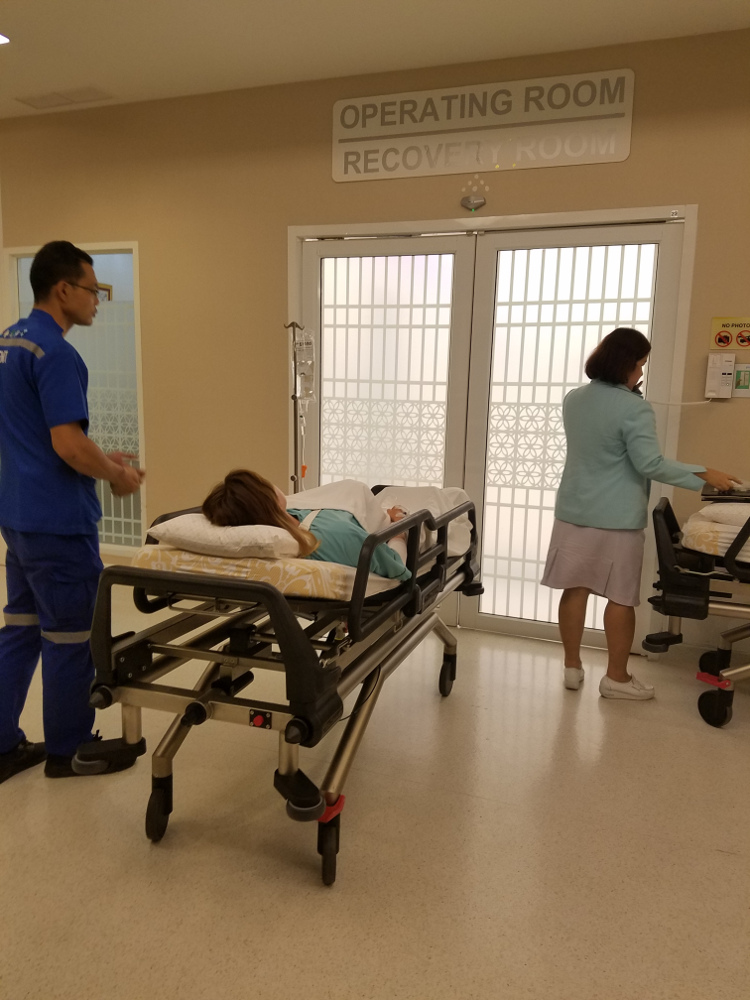
Through examination and into surgery she goes.
I’ve never played this role before, the stressed husband, the anxious partner. I don’t like it but it’s the hand you are dealt. My mind tumbles and drifts like snow.
It’s difficult to chase the threads of your thoughts as they unweave through a million alternate universes. It’s difficult to not be angry at the other more unsafe drivers on the road, speeding through curves with flip flops and swim trunks and no helmets and no accidents. It’s difficult to not think about a different timeline where Mary has a near miss like me and we laugh at the asshole drivers on the road and vow to be more careful and cognizant when we get to Vietnam. It’s even more difficult to stay present, to say to yourself, “This is what is happening. This is the situation we are living through. This is who we are and what we are dealing with. No other situation matters but this one.” It does not matter that with more presence of mind we might have got the license plate and caught the driver. He does not have $13,000 to pay for her surgery. It does not matter that our insurance likely won’t cover us because we, like almost every other Westerner on the road that day, were driving illegally without a Laos license. We saved for this trip and planned carefully for a reason.
What matters is Mary is alive and, for the most part, healthy. She will fully recover. She will have nothing permanent from this experience but some scars, some difficulty going through metal detectors, and finally a travel story that doesn’t bore others to tears (Hey Gap Year students, no one cares how drunk you got in Hanoi or how drunk you got at the Full Moon Party or how drunk you got in Siem Reap).
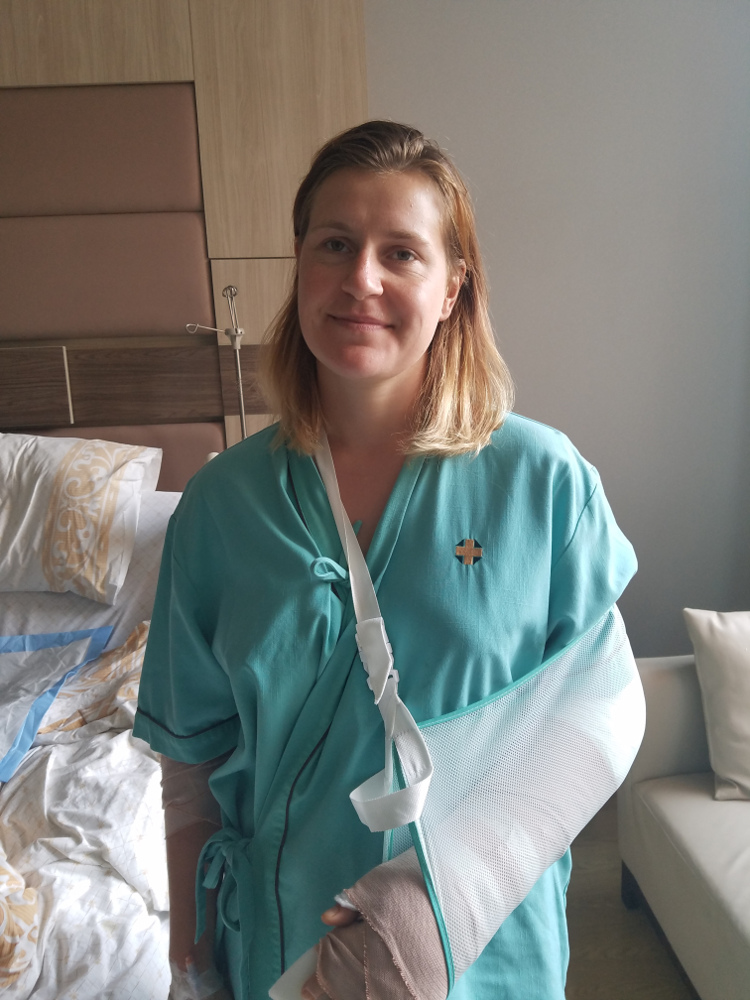
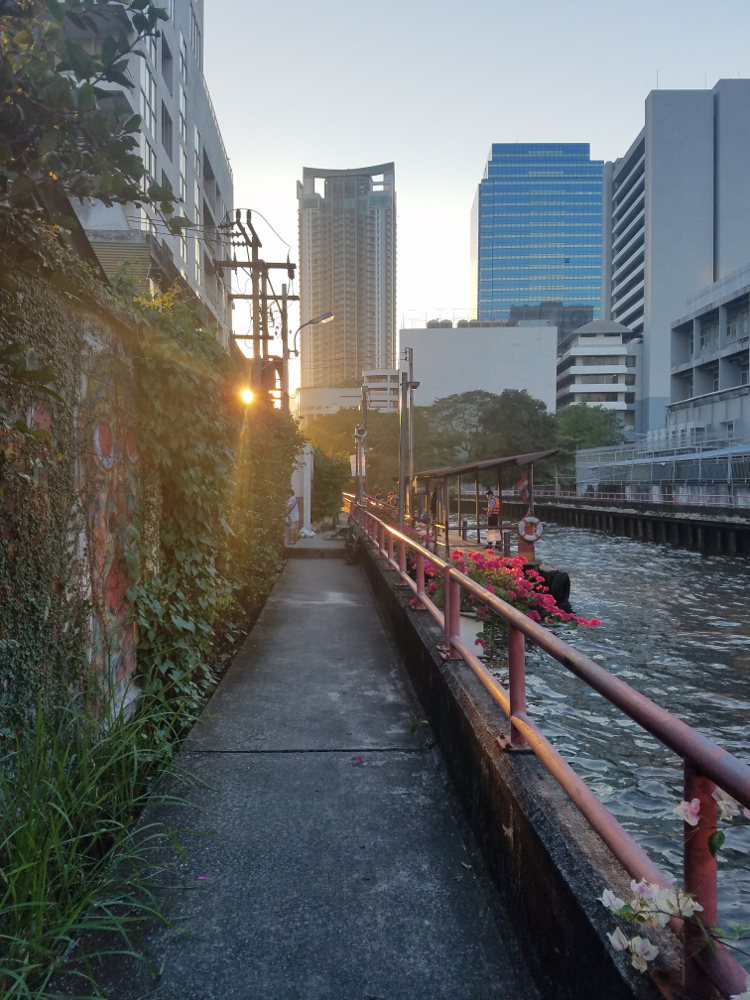
Our life pulls us along at a breathtaking pace. We look ahead and see a different future than the one we saw two days ago. But it is not real. What I see today is no more real than the future I saw on that Sunday when I was most concerned about finding a guesthouse near the Konglor Caves that had other travelers that we could share a tour guide with just to save a couple of bucks.
Now when I close my eyes I can see Mary being pulled into those enormous wheels. Those machinations of destruction. I see her chewed and swallowed and spit out and our lives shattered. It is not real and it is not us. We will be fine and we will still be us. I love Mary Ellen with my whole heart and my whole being. She is my best friend and she is the love of my life. Thinking about her being just an inch away from a near miss, from an adrenaline rush means she was also an inch away from death. We are fortunate to be where we are and we are fortunate to have this support system around us. From the local Lao people that stopped and helped us to the unwavering and selfless support of Mette and Harvey - two strangers that spent their whole day making sure we were safe and interrupting their travels for our sake. The Swiss travelers who stayed with Mary and talked to her and kept her comfortable while I tried not to panic. The rental agency that was understanding and lenient and informative. The hotel staff in Thakhek that saw us limp in and ran over with two martinis (mind readers, I swear!). The taxi driver who had a lead foot to get us to the hospital on time. The doctors here in Bangkok that have waited on us like staff at a fancy restaurant. Dozens of people stopped after the one that did not. The world is full of good people. Love is surrounding us and we are are okay.
This is the end of the original story that I wrote in the short days that followed the accident. What follows is a bit of an epilogue when I posted this story to my site, two years later.
Epilogue
After her surgery in Bangkok, we had to wait four weeks in Thailand for a follow-up appointment before we could be discharged. We could have left for the US at this point and done our follow-ups at home but we only had health insurance converage outside the country. So we stayed. In that time, I frantically tried to pull together all the scraps of receipts and documentation we had for our accident for our insurance claim.
We spent most of time in Northern Thailand - taking it slow and enjoying staying in real hotels with AC instead of sweating in hostels. We get to visit Chiang Mai, Chiang Rai, and Pai. We even ran into another group of travelers who happened to be on the Thahkek Loop with us and had heard about our accident - turns out we were semi-famous in a very small circle of backpackers.
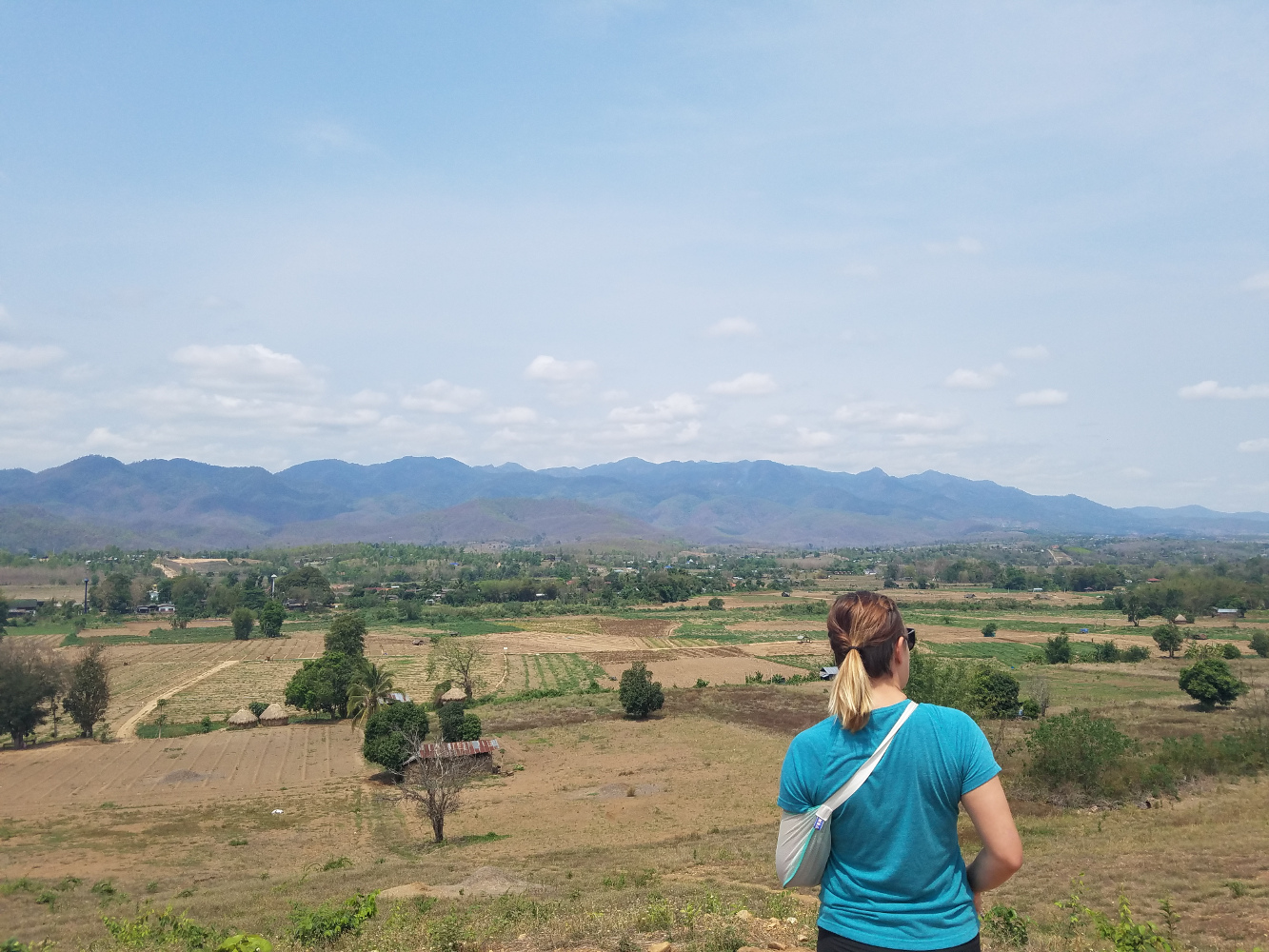
After a month, our visa was near expiration and we were ready to be home. Mary was in need to some stability - to be able to relax and recover in the comfort of a house with family. The initial recovery was extraordinarily painful. Because the surgery placed metal plates and pins, there was no need for a solid cast but the wounds had to be dressed and cleaned regularly.
When we got home, we had a few months of nervously waiting until we got word from our travel insurance company that Mary’s surgery would be fully covered. We were extraordinarily relieved! Thanks World Nomad (seriously, buy travel insurance).
Two years later, and the experience we had in Laos still hasn’t left us. Loud cars approaching from behind are always cause for concern and Mary still has some residual pain in her arm and tailbone. For the most part, however, we have been incredible fortunate. Mary can still work and climb and use her hand and arm fully. She still has amazing scars on her forearm and hand.
There is no follow-up on the perpetrator of the original accident. We are asked this often, “Was he ever found?”. No. And, honestly, I don’t have any desire to see him punished or to have him be found. What’s done is done and he, almost certainly, is in a worse position than us.
I got an email a few months after the accident from the Swiss man who helped us out immediately. Turns out he is a mountain guide in the Alps!
Harvey, our fellow rider on the loop who stayed with us through the hospital visit, is still a good friend. We met up with him later in Bangkok and, in the fall of 2019, we visited him and his wife Polly in Sydney. You can read the report of that trip here.
We are still hoping to teach English overseas, maybe some place with less humidity and more traffic laws than Southeast Asia. We are still hoping to get back to Laos, Myanmar, and Vietnam.